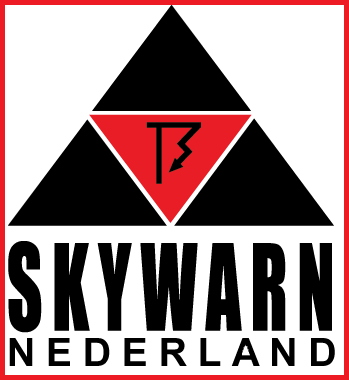
25-09-2024 21:55 | Estofex | m.b.t. 26-09-2024 t/m 27-09-2024

Storm Forecast
Valid: Thu 26 Sep 2024 06:00 to Fri 27 Sep 2024 06:00 UTC
Issued: Wed 25 Sep 2024 21:55
Forecaster: TUSCHY
Numerous level 2 areas were issued over S-CNTRL Europe mainly for excessive rain.
Level 1 areas surround the level 2 areas for similar hazards with lower probabilities.
A level 1 extends from UK/France all the way to the Baltic States with variable risks. An augmented tornado/gust risk extends from France into Germany/Benelux with a more dominant excessive rain risk affecting S UK and the coastal areas. The level 1 becomes more marginal towards the Baltic States with an isolated gust/heavy rain and tornado risk.
SYNOPSIS
A deep positive tilted Rossby wave extends from the Norwegian Basin/Sea to the North Sea, bending SW into the West European Basin with the deepest negative mid-level height anomalies just W/NW of the Bay of Biscay. Not much change of placement and geometry of this wave is forecast as it shifts E during the forecast with its axis forecast to approach the German Bay into the Bay of Biscay.
Despite its slow motion, numerous waves with shorter amplitude circle the main trough and add a more dynamic component to this pattern. In addition, embedded steering vortices within this trough weaken/re-form like a decaying vortex over Irland with a new one evolving E/atop the North Sea. This has some impacts on enhanced DMC activity on a regional scale. The Rossby wave gets framed by positive height anomalies over Russia and next to Greenland but also down into N Africa with rather healthy subtropical cells present.
This anomalous pattern features rather impressive moisture fields, flowing from the E-CNTRL N Atlantic E/NE into the SE flank of the main trough. Layered TPWs for this plume of gradually modifying tropical air show deep anomalous moisture in all levels including the 700-500 hPa layer, where PWs just shy below 20 mm are comparable to the ITCZ activity. Blended TPW anomalies show values in the 40-55 mm range, which is in the 150-200 % range regarding background climatology. This atmospheric river is certainly a rather impressive one as IVT values exceed 1000 kg/ms over most of W into CNTRL Europe, also highlighted by EFI water vapor flux showing peak EFI values from N Spain into the far W Russia (including embedded SOTs up to +2). As impressive as the vapor flux is the EFI precipitation parameter with an extensive region showing values up to 1 and SOT of 1 and more over W/CNTRL Europe.
Next to the moisture, EFI CAPE/shear is also enhanced from France into Germany and highlights a rather impressive CAPE/shear space for this time of year. Despite CAPE being on the low to modest side, a deep/intense hyperbaroclinic zone with intense mid/upper-level winds (+3 sigma at 250 hPa) impacts most of the base and SE fringe of the Rossby wave. This assists in an impressive corridor with augmented severe from W into CNTRL Europe.
Numerous embedded synoptic-scale fronts/waves within this atmospheric river will serve as foci for enhanced thunderstorm activity. The main eye-catcher for organized DMC activity evolves between a wave, which moves from CNTRL France into Germany and a second cold front over far NW France, which shifts E/SE during the forecast and encompasses parts of CNTRL into NE France, Benelux and W/N Germany but also parts of UK into the S- North Sea.
Please keep in mind that ESTOFEX only covers the rain risk, which is accompanied by DMC. Please refer to the local national weather services regarding the more general QPFs.
DISCUSSION
... W-CNTRL to NE/E France, Benelux into W/NW Germany ...
An overlap of constantly cooling mid-levels (500 hPa dipping into the -20C range over far N-France) atop an unseasonable moist low-tropospheric airmass results in a broad belt of low to moderate instability with MUCAPE in the 200-500 J/kg range. Forecast soundings show effective ELs of 6-7 km AGL, so thunderstorms should take profit of more or less all of the extreme 30-45 m/s DLS. 0-3 km shear remains constant in the 15-20 m/s range with patchy 0-1 km shear peaks of similar magnitude.
Forecast hodographs are very long but also curved in the ongoing WAA regime with LCLs in the 200-600 m range. LLCAPE will be on the order of 100 to patches of 200 J/kg, so the main question remains if shear could be too much for this amount of CAPE. However, merging cells should be able to attain a broader/more robust updraft status and interaction with the background shear/dominating linear pressure perturbation dynamics should push storms away from the hodograph, causing rather impressive SRH values with lots of streamwiseness but also enough streamwise vorticity in the inflow layers.
Another uncertainty is how discrete thunderstorm activity remains with EZ driven guidance being more aggressive in clustering, whereas others supporting more semi-discrete cells. Q vectors indicate numerous waves with compact/enhanced forcing within a broad belt of subsidence and hence a still substantial spread in potential convective activity along this corridor is noted in NWP guidance.
For now a broad level 1 was issued to highlight the general risk of strong to severe gusts with more robust cells. Amount of 0-3 km shear also points to bowing line segments with an enhanced gust risk.
A tornado risk is certainly present with any longer-lived thunderstorm and rapid translation of the cells would also support a significant/long-tracked event. No upgrade to a level 2 was performed as it remains unclear, if a more clustered tornado event next to discrete thunderstorm activity materializes, caused by ongoing but important issues of the MSLP and geopotential height geometries. Some models would support a regional outbreak potential of rotating updrafts e.g. for far NE France to Belgium/Netherlands into NW Germany with nowcast becoming an important issue!
(Alleen de voor NL en aangrenzende gebieden relevante tekstdelen overgenomen, klik hier voor de volledige forecast, red.)
Onweer/blikseminslag | Tornado/hoosverschijnsel(en) | Verwachtingen/waarschuwingen | Wateroverlast/(zware) neerslag | Wind/storm (-schade)